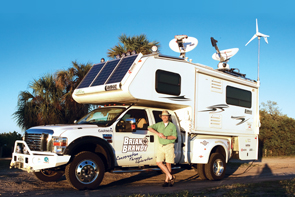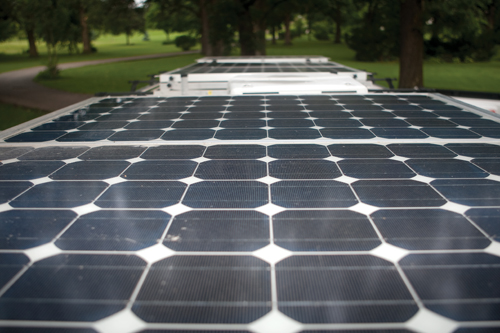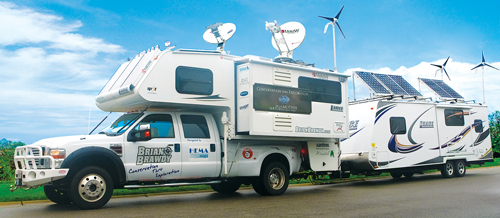Boondocking is in our blood. Like the want of two full lungs of untamed air, a nose brimming with the smell of fresh wilderness, ears tuned to birdsongs or to the refreshing sounds of nothing at all, eyes gently focused somewhere between you and the distant horizon, time alone in the wild reminds us of who we are. Heading “out there” brings us back to our inner core.
And location doesn’t matter, because boondocking isn’t just about geography or terrain; rather, it’s about temperament — your temperament. “Where is my wild?” My friend Bob Difley asks a great question. “Can you see the Milky Way from your campsite?” That’s as good a test as any.
Relying on yourself, going it alone is the one aspect that calls more RVers to adventure than any other benefit of boondocking. That sense of liberty and independence, of facing the unknown autonomously is a birthright that boondockers gladly embrace, while surrendering the status quo of calendar and clock.
In the 21st century, boondocking has taken on a dual purpose. You can use your skills for escaping the everyday or also for evacuating in case of an emergency situation. Think of your RV as the vehicle of choice if the unthinkable happens. Your “just in case place” to “get away from it all” or your “get out of the way” vehicle should you be facing impending natural or man-made disasters.
I’ve set up my Lance camper and trailer as my Self Reliant Mobile Residence, or SRMR, with the ability to harvest the natural energies of the sun, wind and rain, allowing me to both sojourn and to survive comfortably. I like to think of the SRMR as being perfect for boondocking and bugging out.
Prepare to Boondock
So, what are the basics? There are many tips we can use to bring the far away to our own front door without sacrificing the creature comforts of home. A large part of getting out there is staying out there. So how do we do it?
Really, it all comes down to power, to your ability to sustain your RV and your body with various energy needs. AC generators are great tools, but what of those situations where your gas or diesel get low and/or LP-gas supplies have run out and the ability to refill them is a no-go? Using the natural energies of the sun, wind and rain prolongs your boondocking scenario and gives you the ability to go off the beaten path.
When I decided to go off the grid, my first step was solar power. I’ve always been fascinated by the unplugged potential of the natural rays of the sun. From roughly 92 million miles away, the photons
reaching the earth can be collected, harvested and used as a power supply; that concept still blows me away.
To get started, the engineers from My Solar Backup and Lance teamed to design the SRMR with five 150-watt solar panels and the plug and play Power Hub. The panels, or photovoltaic cells, are secured directly to the standard roof-mount racks from Yakima using u-bolts. They are designed with four locking pins on double-hinged frames, allowing me to manually pivot the panels to accommodate the rays of the sun. The three-position setup allows for every angle I need, which is good because drilling fewer holes was my objective. All of the wiring enters the RV through just one hole in the roof directly above the closet. The junction boxes, charge controllers and battery hookups all live neatly at the back of the closet.
The Freedom SW 3000 Pure Sine Wave inverter from Xantrex is wired directly to the batteries and is housed under the bed. I cut special vents in the footboards to allow fresh air to circulate. The inverter features a high surge rating, and is complemented by temperature compensation and multistage charging. The high operating temperature range and conformal-coated circuit boards allows me to use the Freedom SW in all climate conditions — a huge plus for me.
Next came the wind energy, an idea born a few years back while relaxing on a dock in Tampa, Florida. At sunset, I watched the silhouette of a yacht gliding into harbor, and attached to its main mast was the black outline of a spinning wind turbine. Staring at it, I wondered that if it could work on a boat why not on an RV. I checked with a few experts, who were concerned about the noise and vibration. Shortly thereafter, I took a pass on their warnings and hit a local metal fabrication shop, helping bring my vision to life in the form of top and bottom corner-mounting brackets on the back of the camper and trailer. The three-section manual telescoping aluminum poles hoist the Air Breeze wind turbines to 28 feet. In 28 mph wind, it generates 160 watts of power.
And finally, I needed to have my own source of water. No hookups? No worries. Harvested rainwater is the way to go and to stay out longer. I’m often asked questions such as, “People drink rain water? Is it safe? Do you drink it?” Truth is, harvesting rainwater is a necessary method of acquisition around the world. It needn’t be filtered or prepared. That said, I’ve found pelicans, raccoons, pigeons, squirrels and a host of other critters on the roof of the SRMR, so after collecting rain from the RV’s rooftop, I use an onboard pump and filter, which moves the rain through a Katadyn Base Camp water-filtering system and then directly into my freshwater tank.
Boondocking in Action
It’s easy to get caught in the glitz and bling of solar panels, wind turbines and rainwater-capturing devices, focusing on the collection of these resources and not the distribution of them once captured. But today, there are some pretty amazing technologies for getting the most out of your stored power. First, replacing all of the incandescent bulbs inside and out with LEDs helps to dramatically reduce the energy demands of lighting the SRMR. They are easy to install and draw a fraction of the power that regular bulbs do, and they generate significantly less ambient heat. Additionally, conservation continues to be king: If I’m not using lights or other appliances, obviously I turn them off.
Conservation is key when it comes to water resources as well. For instance, turn off the water when brushing your teeth, and collect the water normally wasted while waiting for hot-water flow to use it later for dishwater or for flushing the toilet. Also, if I know I’ll need more water to prepare for longer stays, I use sections of cleaned PVC pipe, capped at each end, to store additional amounts of water.
The beauty-and-the-beast dichotomy of boondocking is fairly straightforward. Being out in the middle of nowhere most times means you are out of reach as well — out of reach of paramedics, police officers and any external help. In an emergency situation, would you know how to administer first aid? Do you have an updated first-aid kit? Do you know how to perform CPR or the Heimlich maneuver? Boondocking might mean you need to be your own hero or heroine. It’s a great understanding to keep in mind.
I was once asked, “Why boondocking?” Though I had no one direct answer, one of my all-time favorite quotes, from “The Tables Turned,” by William Wordsworth, jumped to mind: “Come forth into the light of things. Let Nature be your teacher.” Boondocking makes you and me the perfect students, and I love that kind of learning.
About the author: Explorer Brian Brawdy spreads the message of “Conservation through Exploration,” while reminding us that “exploration is the sign of a healthy mind.” Since purchasing his 1181 Lance camper, personally designed to harness the natural energies of the sun, wind and rain, he has traveled North America full time in his RV. Touring as an outdoor adventure expert, Brawdy explored 48 states in 10 months with more than 100 personal appearances and 70 television news segments.
Learn more about Brawdy by visiting his website at www.brianbrawdy.com.
Sources
Air Breeze, Southwest Windpower Inc., (928) 779-9463, www.airbreeze.com.
AM Solar (Solar-power systems), (541) 726-1091, www.amsolar.com.
Command Electronics, (269) 679-4011, www.commandelectronics.com.
The Jirah Company (LED lamps), (909) 297-1926, www.jirahled.com.
Katadyn Base Camp, (800) 755-6701, www.katadyn.com.
My Solar Backup, (877) 327-0365, www.mysolarbackup.com.
Star Lights Inc. (LED lamps), (800) 883-5444, www.starlightsinc.com.
Xantrex Technology Inc., (800) 670-0707, www.xantrex.com.
Yakima Products Inc., (888) 925-4621, www.yakima.com.

